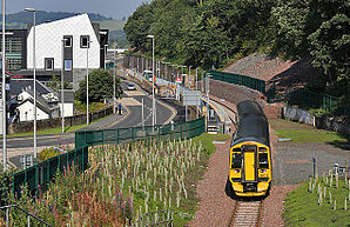Transport planners should allow for ‘pessimism bias’ when forecasting future revenue from new or re-opened rail schemes, a sector expert has said.
Consultant David Spaven said ‘shocking’ under-forecasts of passenger numbers for Scotland’s recently opened Borders Railway had helped create a poor business case for the line, which in turn had led to a reduction in the amount of double track built on the line and an unreliable service.

The Borders Railway at Galashiels Station
This then led to a subsequent loss of passenger numbers due to late running trains, according to experts, who are now calling for modelling to be overhauled.
The line, which opened last September saw 694,373 passenger journeys in its first six months of operation, 22% higher than projections.
Passenger numbers at individual stations were many times higher than had been predicted. Tweedbank station saw 183,918 trips, nearly ten times the projected figure of 18,978.
Mr Spaven, principal of consulting company Deltix, said under-forecasts had led to Transport Scotland slashing the length of double track on the line from a planned 16 miles to nine and a half miles.
He added that figures compiled by campaigners using data from Real Time Trains showed a low rate of trains arriving at the ‘right time’ at Tweedbank and Edinburgh Waverley stations.
According to Mr Spaven, this unreliability had particularly impacted on stations in the Midlothian area, with late-running trains often omitting intermediate stops to catch up time and resulting in fewer passengers.
Mr Spaven told Transport Network: ‘Rail re-opening efforts throughout Britain are often stymied by the imposition of additional costs to allow for “optimism bias”. Is it not time to factor in “pessimism bias” for revenue forecasting?’
Transport Scotland said the forecasting methodology used was in line with industry practice and that it kept methodology under constant review.
A spokesman added: ‘Decisions on the amount on double tracked line on the Borders Railway were made after detailed engineering studies which were undertaken in order to deliver a reliable and robust service performance alongside value for money for the public purse.
‘The length of double track on the line allows for both future growth in numbers and timetable requirements to be achieved, as evidenced by the robust performance, which is at least in line with the network average despite exceeding forecast passenger numbers.’
Register now for full access
Register just once to get unrestricted, real-time coverage of the issues and challenges facing UK transport and highways engineers.
Full website content includes the latest news, exclusive commentary from leading industry figures and detailed topical analysis of the highways, transportation, environment and place-shaping sectors.
Use the link below to register your details for full, free access.
Already a registered? Login